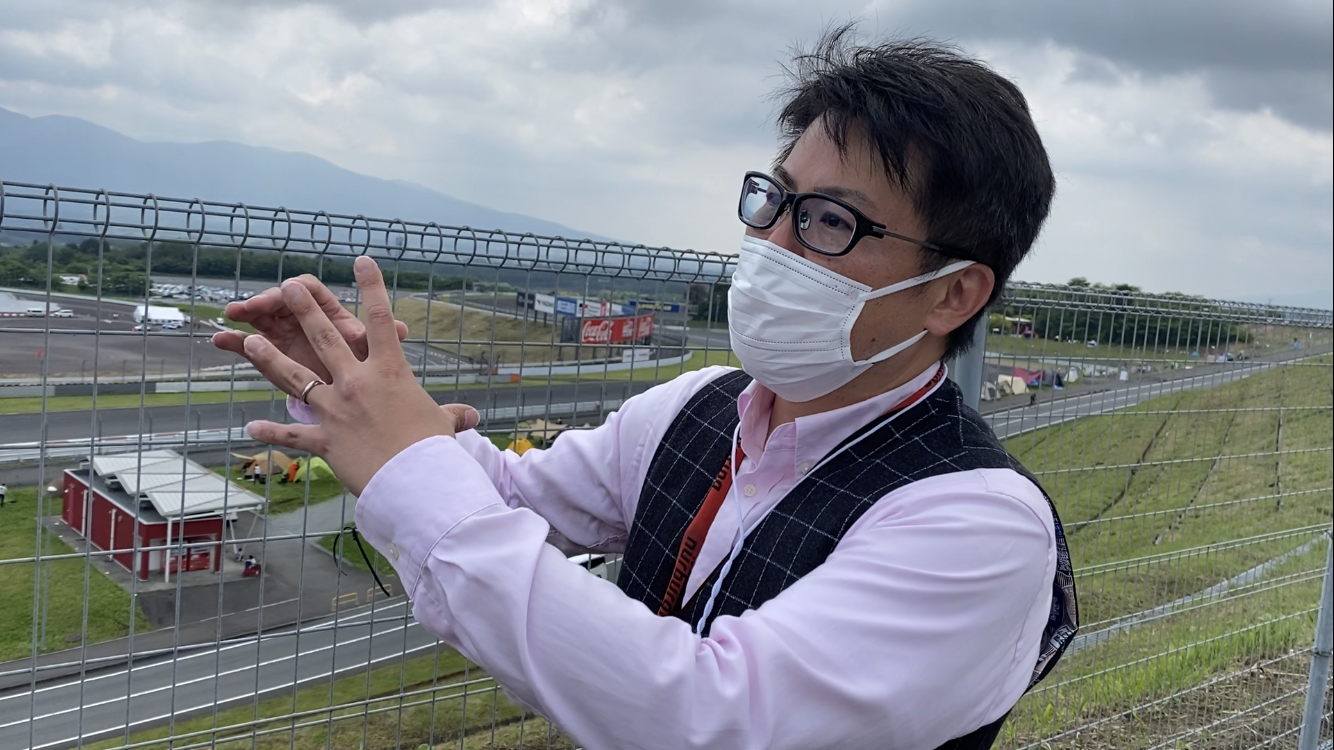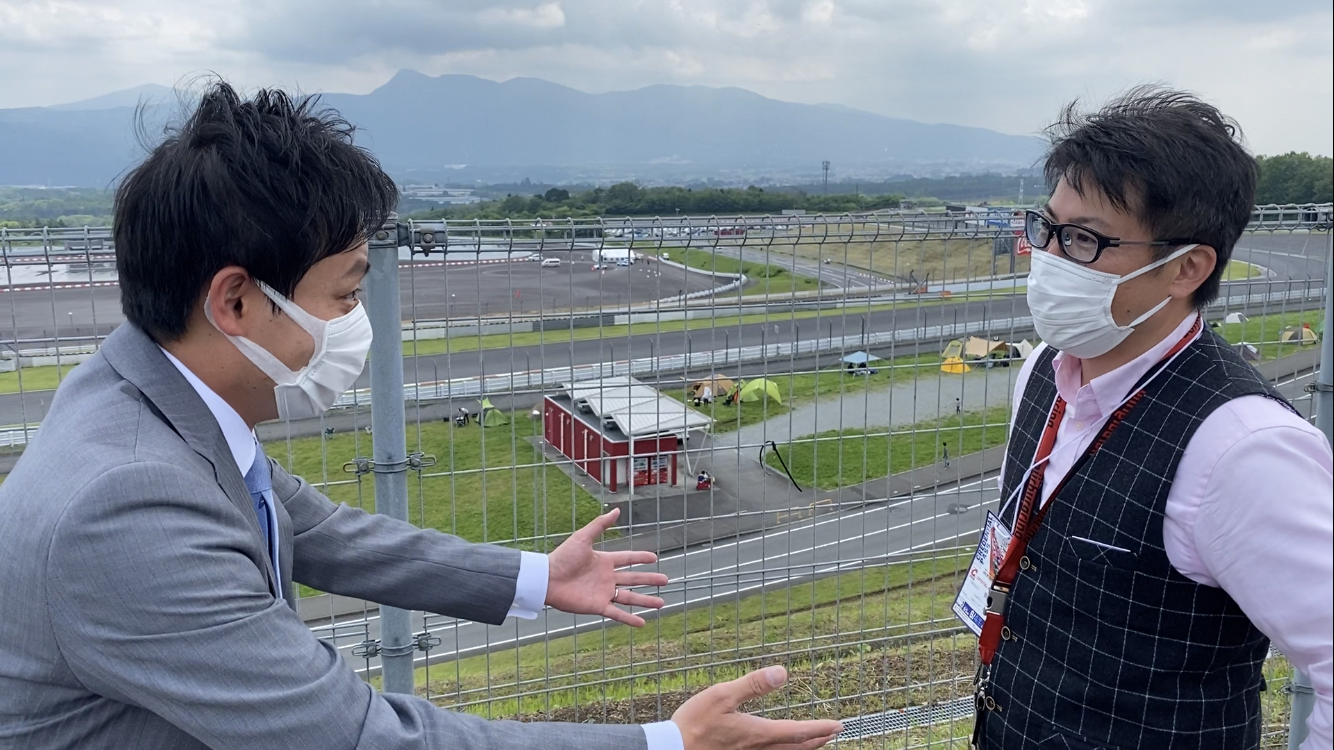
Yamamoto last year described the hydrogen-powered engine as "a catalyst that unleashed our dreams." Since then, he has attended every race to see the technology's progress for himself. A year on, how does he see this challenge?

This year’s Super Taikyu Fuji 24 Hours Race marked one year since the debut of the hydrogen-powered Corolla.
Ahead of the main 24-hour race, Toyota Times reporter Kyonosuke Morita interviewed Shinya Yamamoto, an automotive analyst who described the hydrogen engine at last year’s race as “a catalyst that unleashed our dreams.”
No doubt in performance
Morita
We are here at the same place a year later. We’re even dressed pretty much the same, except for your glasses, maybe?
Yamamoto
Just as the hydrogen-powered Corolla is now based on a GR Corolla, rather than a Corolla Sports, I’ve also had some minor updates.
Yamamoto was not fully convinced whether hydrogen-powered engines for motorsports were viable when learning of Toyota’s announcement on April 22, 2021. Initially, he could not imagine a race scene with a hydrogen engine vehicle.
Since then, he has been trackside for every race of the hydrogen-powered engine. How have Yamamoto’s impressions changed?
Yamamoto
There’s no doubt anymore. I had a chance to get behind the wheel at the media test drive, and I couldn’t help but think that the hydrogen-powered engine feels better than a gasoline vehicle.
And having watched the hydrogen-powered Corolla compete, so far the car has taken everything in stride. Of course, you never know what will happen in a 24-hour race, but the underlying technology already provides sufficient performance.
Factory-backed motorsport teams a game-changer
Over the past year, the hydrogen-powered engine has achieved 20% more output and 30% more torque, making it outperform similar class gasoline engines and allowing for a 20% longer driving range. At the same time, hydrogen refueling time has been reduced by 70%.
How does Yamamoto view the improvements?
Yamamoto

Although lap times aren’t everything, speed is certainly crucial. As driver Masahiro Sasaki said, you can’t explore reliability or durability at races without the ability to drive fast.
The idea is to determine the engine’s limits first, then branch out from there.
I saw great improvement in hydrogen refueling too. At this race last year, it took about five and a half minutes to refuel hydrogen, and now it’s down to one and a half. How’s that for improvement!
What surprised me even more was a prototype of the liquid hydrogen Corolla waiting in the wings, the next car up Toyota’s sleeve.
Another change Yamamoto pointed out was the growing number of like-minded partners working towards carbon neutrality.
This year’s 24-hour race saw various factory-backed teams from Toyota, Subaru, Nissan, Mazda, and Honda.
Many of them compete with cars running on carbon-neutral fuels to develop future technologies in the racing field.
Morita
When the hydrogen-powered Corolla made its debut a year ago…
Yamamoto
In a sense, it was flying solo, wasn’t it?
Morita
But the landscape and people’s perspectives have changed considerably in a year.
Yamamoto
It’s incredible how the atmosphere has changed.
In past energy crises, many manufacturers withdrew from motorsports. The oil shocks in the 1970s, as an example, pushed all of the factory-backed teams to suspend their activities.
In a sense, I think carbon neutrality is a different form of energy crisis. But this time, factory-backed teams are actually increasing their stakes in motorsports. That’s a game-changer.
It would be easy for automakers to say that “we have many other things to do.”
But the hydrogen-powered engine served as a starting point for automakers to hone their carbon-neutral technology in races. I found that to be amazing.
For one goal with different means
As he witnessed the progress for a year, Yamamoto says his feelings before the race are somewhat different from last year.
A year ago, he was unsure if the hydrogen-powered car could really complete the race, but now, he is simply excited about the prospect of ever-better results.
Last year, Yamamoto described the hydrogen-powered engine as “a catalyst that unleashed our dreams”—a year on, what is his verdict?
Yamamoto
It certainly did unleash our dreams, and many others have stepped in to pursue theirs.
We now have the hydrogen-powered engine, carbon-neutral fuels, and biodiesel. I think seeing that wider range of efforts in motorsports has significant meaning.
A year ago, some people argued that battery EVs were the only viable option and that others should be phased out. In response, President Akio Toyoda asserted that “carbon is our enemy, not the internal combustion engine.”
Now, looking at the landscape in front of us, you can’t help but see internal combustion engines as allies in achieving carbon neutrality. That’s how I felt.
Morita

So, it's a 180º turnaround in the past year?
Yamamoto
Absolutely. The winds have suddenly shifted.
Morita
What do you think brought about the shift?
Yamamoto
It comes down to the catalyst unleashing our dreams.
Everyone was waiting for someone else to take the first step, and they jumped on board when the hydrogen-powered engine did just that last year.
In the end, we all have the same goal: carbon neutrality. The means might differ, but we are heading to the same destination.
Morita
That’s what Morizo has been saying all along.
Yamamoto
And I think the hydrogen-powered engine gave us encouragement there.
Akio describes Toyota’s efforts to race a hydrogen-powered engine as “purposeful passion and action” towards creating a carbon-neutral society.
As like-minded partners respond to that impassioned call to action, the options for carbon-neutral engines are growing.
Yamamoto once again accurately summed up the role of the hydrogen-powered engine by capturing the changes in the automotive world.
Morita
This year’s 24-hour race is another chance to hone technologies by testing many things through a repeated cycle of building, breaking, and fixing vehicles.
Yamamoto
I don’t want the hydrogen Corolla to break much this year, though. Last year the car was out of action for about four hours, and I feel that completing the 24 hours in the truest sense can demonstrate its progress.
Morita
Thanks for joining us again and proving your endurance.
Yamamoto
I’ll keep my eyes wide open for the next 24 hours!

